Antarctic Marine Life and Adaptations
The undersea and even under-ice landscape of Antarctica can be a Technicolor contrast to the monochrome landscape above the water thanks to a rich fauna of marine invertebrates. Surviving in this frigid realm of intermittent food supply poses difficulties all of its own.
Marine invertebrates in Antarctic waters are one of the hidden gems of the coldest continent. One of my favorite and most vivid memories of Antarctica is of setting out from base under an overcast sky and through a landscape of black, white, grey and muted blues to then drop through a hole in the sea-ice to dive into an alternative vivid multi-coloured world.
While the fish may not be particularly notable for their colours, the invertebrates can be as bright and varied as those on a coral reef. This clearly isn't a coral reef however and low temperatures combined with long periods of little or no food availability lead to a whole host of adaptations being needed to survive here.
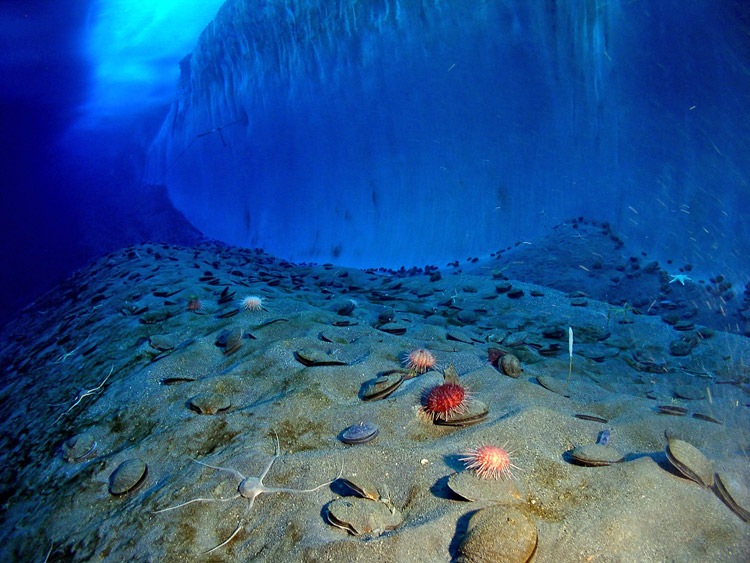
Underwater at the edge of the ice
The Antarctic Ocean and seas around the continent provide as unique an environment to the creatures living in them as do the icy wastes above the waves. On the one hand, there isn't really an "Antarctic Ocean" as it is just the southern most parts of the Pacific, Atlantic and Indian oceans. There is however a feature called the Antarctic Convergence a circumpolar strip of sea around 40km wide (25 miles) varying between about 45° and 60° South. The exact position is variable, and it wanders back and forth slowly over the year by around half a degree of latitude (around 56 km / 35 miles). It is where there is an upwelling of deep flowing waters meeting from the north and the south. The surface temperature changes by 2-3°C across the convergence (also known as the polar front), which might not sound like a lot but it is sufficient to make the Antarctic Ocean particular and distinct.
A particularity and distinction that also extends to its marine life.
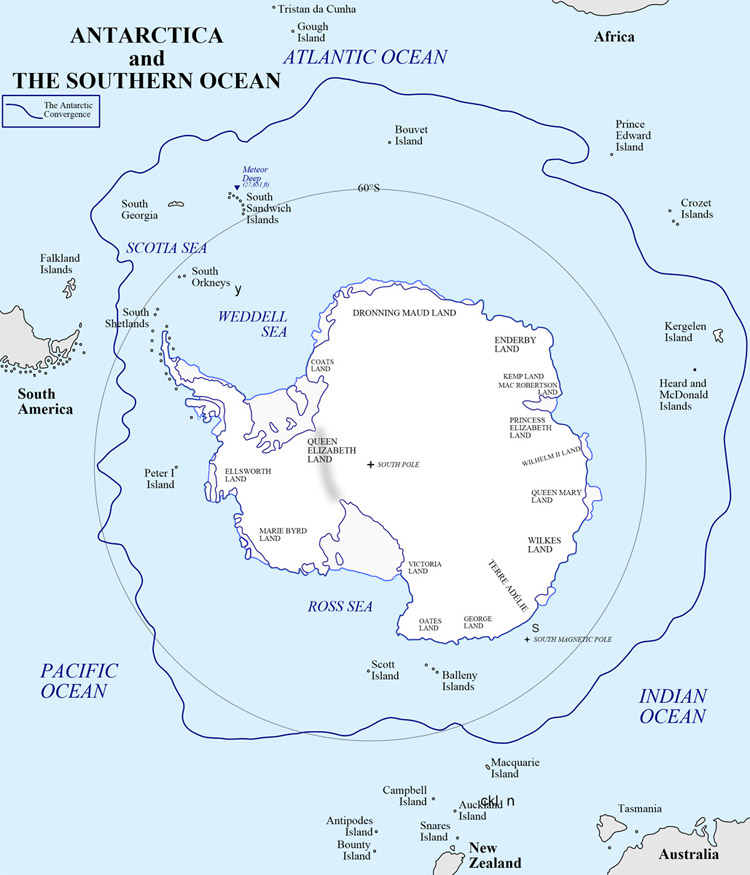
Antarctica and the Southern Ocean
the wavy blue line shows the position of the Antarctic Convergence
The Antarctic Convergence has been in place for around 20 million years during which there has been very little exchange of marine organisms across it. The temperature within the Antarctic convergence area is very stable varying only from about +3°C to -2°C over the year and probably since the convergence arose in the first place. The lower limit is set by the freezing temperature of sea water.
This means that the animals that live in Antarctic waters have been subjected to very stable, very cold temperatures for a considerable evolutionary period which has led to some significant differences when they are compared to marine animals from other parts of the world.
Is there anything different about the Antarctic Ocean marine fauna?
Everybody who has worked in Antarctic waters has
been struck by the peculiar absence of crabs, lobsters, shrimps.....in
shallow waters.
H. Broch 1961
Decapods
It is sometimes stated that there are no Decapod crustaceans in Antarctica (crabs, lobsters etc.), while this is not entirely true with 22 different species having been recorded, they are no where near as common as they are in other seas where they are usually both very obvious and common, clearly playing an important role in the marine ecosystem. In addition to their scarcity in Antarctica, they are restricted to places where the water is above 0°C, largely due to a characteristic of their metabolism that means that they are unable regulate magnesium levels below around +1°C.
The fossil record shows that there were decapods present but had disappeared from Antarctic waters in any numbers from about 15 million years ago.
In recent years, spider crabs have been found in several locations around Antarctica, which has led to warnings of how an "invasion" could place much of the Antarctic marine fauna in danger as this "new" predator is now able to return to Antarctica now that sea temperatures were rising as a result of global warming. Further studies however have indicated that these spider crabs were always present and have simply only just been discovered, they are survivors rather than invaders.
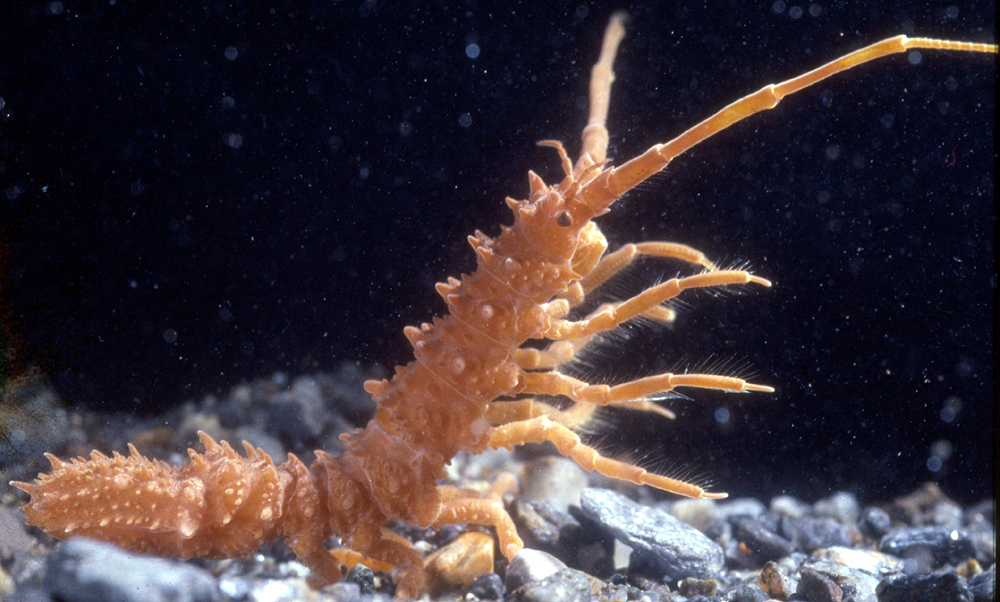
Without decapods, other organisms take their place
this is Antarcturus signiensis, found only in Antarctica
Fish
The Antarctic Convergence formed a barrier to shallow living fish, though less so to those of the deep sea. About 25% of deep sea fish species in Antarctica are natives found no-where else compared to about 85% of coastal species, in particular the pelagic fish fauna (those that live their lives swimming in the water column rather than in association with the sea bottom, rocks etc.) are very species poor in Antarctica. There are no sharks or rays in Antarctica.
Most of the approximately 100 species of these coastal fish belong to a group called the Nototheniodei (Notothenids or Antarctic Cod). The adaptive radiation within a marine fish group as shown by the Notothenids is a very rare example and they dominate much of the Antarctic fish ecology. What allowed the divergence of this group rather than others was the development of protein anti-freezes in their blood allowing them to survive where other fish species and groups died out. In evolutionary terms, gaining an advantage and running with it.
The result - Notothenids do not have powerful jaws and along with the lack of decapods this means that there aren't any hard shell crushing predators in Antarctica. The Antarctic ecosystem has been described as resembling that during the Paleozoic (350 million years ago) in the rest of the earth's oceans where the top predators are ribbon worms, starfish and sea-spiders. Antarctic invertebrates tend not to be very well protected by external armour in the way that invertebrates are elsewhere in the world as they simply don't need it as there aren't really any threats to them.
Nemertean worms and sea-stars swarm on a seal carcass in McMurdo Sound, Antarctica
Surviving the cold
Ice is a very dangerous substance to living tissues, it grows as vicious little pointy crystals that easily stab through cell membranes killing cells. This is what happens in frost bite when living tissues freeze to become used-to-be-living tissues, the damage is permanent and is not reversible by thawing.Freezing isn't as entirely straightforward as might be imagined however, often a nucleation point is required for the freezing to begin, without this, it is possible for a liquid to reach its freezing point or get even colder, but not turn to a solid and freeze. An ideal nucleation point for the growth of ice is an ice crystal itself.
Deep ocean animals such as fish in Antarctica never actually encounter ice as they live too deep in the sea. They can be caught and brought to the surface where they can freeze instantly on contact with ice which causes crystals to grow in their cold tissues. So one way of surviving very cold temperatures as a marine animal is to make sure you don't actually contact ice which means you can become supercooled (below freezing point without actually freezing) without fear.
Other marine animals lower the freezing point of body tissues to avoid freezing in the first place. Sea water freezes at -1.86°C though the exact temperature depends on the precise salinity (amount of salt dissolved in the water). Animals can use the same idea with chemicals dissolved in their body fluids to lower their freezing points to below this temperature, it doesn't need to be far, just a little below that of the surrounding water. As long as the concentration of dissolved chemicals in the body fluids is greater than the surrounding sea-water the body tissues can escape damage by freezing.
Antifreezes - The antifreezes you may have heard of that protect vehicle engines in the winter work by depressing the freezing point of the engine coolant fluid. The antifreezes of the Notothenid fish however work in a different manner. They don't prevent the formation of ice crystals but they do prevent their growth and help stop damage to cell membranes and other components. The antifreezes are made of proteins and glycoproteins (protein + sugar) and they work like tiny little molecular cushions or safety guards on the ends of the sharp stabby ice crystals, preventing the growth of the crystal and the damage that it might cause.
Other adaptations
Longevity
Many Antarctic marine invertebrates live extraordinarily long lives. Even the ubiquitous krill the basis of many food chains and the organism that is eaten by just about everything larger than it from fish to all kinds of birds such as penguins to seals and the largest whales can live up to ten years with an average lifespan of six to seven.
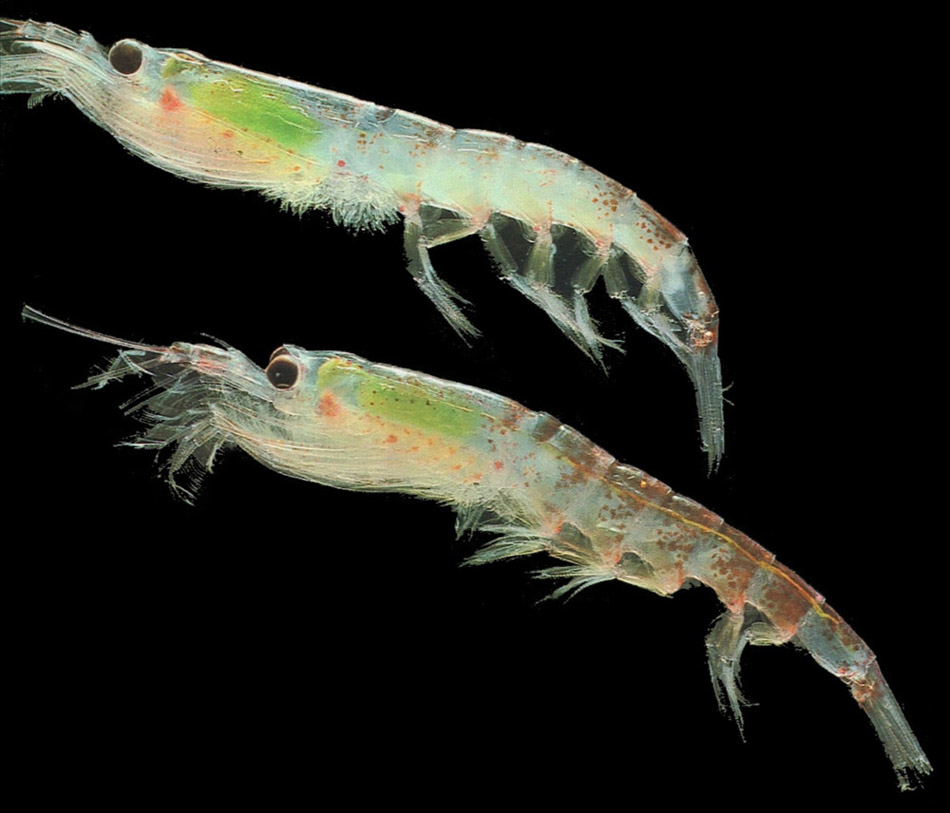 Krill
Krill
Cold temperature is the main reason that things live so long. They just live lives that are slower than those of other organisms, everything takes longer.
Some shell forming molluscs such as Brachiopods have growth lines similar to the growth rings in tree trucks that show them to be several decades old.
Longevity is also sometimes linked with gigantism, the marine annelid worm Aglaophamus trissophyllus for instance lives a long time and grows very slowly during a life span that is from three to seven times longer than that of similar species from warmer waters. This is not universal however and in the same way that only some Antarctic species are giants, only some live long lives (not necessarily the giant ones).
Icefish
Almost inevitably there is something called an Icefish in Antarctica, such as Chionodraco hamatus pictured below. . There is a group of Icefish, 25 species known less catchily as the Channichthyidae, a group at the Family level of organization and a sub-group within the Nototheniodei. Inevitable though these fish really do earn the name.
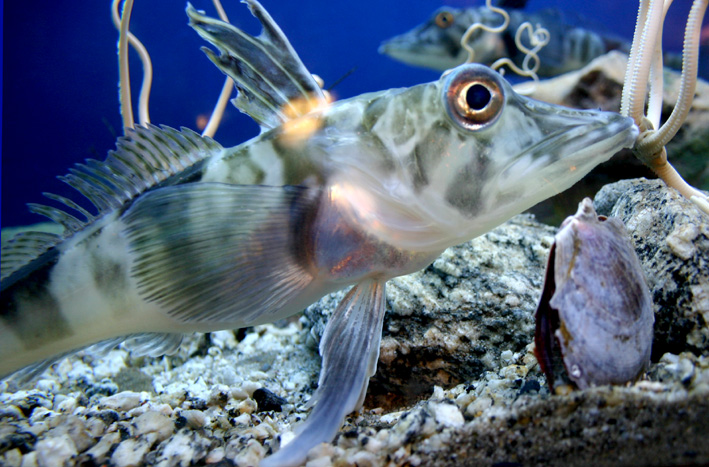
The most obvious and peculiar thing about the icefish is that they completely lack haemoglobin, the pigment that makes blood red, so many of the species appear a ghostly white, a feature that is particularly noticeable in the gills. Whereas the gills of other fish are a deep wine red colour, the gills of icefish are translucent white.
They don't have red blood, but they do have blood, lots of it. They get by without haemoglobin:
- by having a much greater volume of blood than other fish
- by having a greater cardiac output (the heart pumps lots of blood)
- by having increased blood flow
- by having low viscosity blood due to the lack of red blood cells
- by having thin skin rich in capillaries across which oxygen can diffuse.
This works because oxygen dissolves far better in cold water than in warm water. The icefish take advantage of this fact and that coastal Antarctic waters are well oxygenated in order to make energy and resource savings from not having to make red blood cells filled with haemoglobin protein and requiring iron. Like many of their relatives in the Nototheniodei, they also have antifreeze proteins in their clear blood, as you might expect from something called an icefish!
 Gigantism
GigantismA commonly found feature amongst polar benthic (bottom dwelling) organisms, both Arctic and Antarctic. This is not always as impressive as it may sound, it's not Jack and the Beanstalk type gigantism, but means that many polar organisms are larger than their counterparts in other seas.
One group that demonstrates gigantism are Pycnogonid sea spiders (picture right). A common British species Pycnogonum littorale for instance has a leg span of around 20mm whereas polar species may have leg spans of up to 750mm.
Polar gigantism is one form, there is another called abyssal gigantism which is the same thing but applies to very deep water organisms (that live the "abyss"). The two may well become confused, particularly in giant deep water polar organisms where it's not entirely clear which form of gigantism is taking place.
No-one is really sure why it is that some invertebrates grow to larger sizes in polar waters. The most popular hypothesis is to do with dissolved oxygen in the sea-water. Gases generally act the opposite way to solids when they dissolve in that the colder the water, the more easily they dissolve. So cold Antarctic waters are usually high in dissolved oxygen. If you have a fish pond, you may notice on a hot summers day that the fish sometimes "gasp" at the surface as they try to take in extra oxygen from the air as their gills get less from the warm water that now holds less oxygen.
As an animals size increases its surface area to volume ratio decreases, so there is relatively less gas exchange surface available to supply the tissues with oxygen. As there is more oxygen available in cold water, the animal can become larger than it would in warm water. Add to this the reduced requirement for oxygen due to a slower metabolic rate from the lower temperature and there is more scope for growing large. Whether or not a animal actually grows large is dependent on gaining an advantage from doing so, something that doesn't apply to all polar animals, but it does at least allow for the possibility.
Recent studies have cast some doubt on the universality of this idea, though it remains probably still an important factor if not necessarily the only one.
Nemerteans
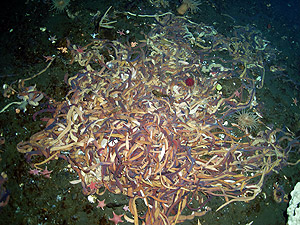
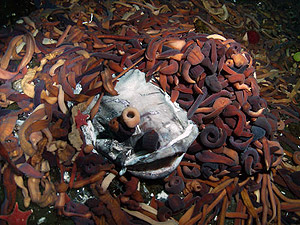
A pile of nemertean worms around a fish head, left picture with some of the worms brushed aside, right picture. Antarctic representatives of the Phylum Nemertina, the proboscis worms provide good examples of the above adaptations to cold environments.
A common species is Parborlasia corrugatus which is widespread in Antarctic waters at depths from 0 to over 3,500m. It varies in colour from pale cream to dark brown/grey stopping off at a few reddish stations in between. At lengths of up to 1 or 2m and diameter of 2cm and weight of up to 100g it is an example of an Antarctic giant when compared to non-Antarctic proboscis worms.
They eat almost anything from faeces to live things that can't escape. It lacks a circulatory system, the high levels of dissolved oxygen in cold Antarctic waters means that they can get by without by just absorbing oxygen through the skin. If oxygen levels fall it flattens its body to reduce the distance for diffusion of the oxygen to get to its body tissues (and of carbon dioxide to diffuse the other way).
It is admirably adapted and one of the most physically unpleasant critters I've had the misfortune to encounter. As a fish physiologist I had to set nets to catch my fish (the species I was working on was a Notothenid, Notothenia neglecta). Sometimes we couldn't get out to retrieve the net the next day due to the weather. By the time we did get to it (sometimes up to a week later) some of the fish would have died or been killed, they weren't recognisable as fish when we pulled the net up as they were in the middle of a large ball of P. corrugatus and small amphipods that were feeding on the remains. The amphipods would fall off like confetti but the worms all stretchy and slimy with snot-like mucous would have to be pulled off so we could get our net back, not to mention our feeling of guilt at the poor fish that had died trapped in the net. Horrible yucky animals that always seemed redolent of death.
Bibliography
Antarctic Crabs: Invasion or Endurance? Huw J. Griffiths
mail, Rowan J. Whittle, Stephen J. Roberts, Mark Belchier, Katrin
Linse, 2013
Antarctic Fish and Fisheries Karl-Hermann Kock 1992
How the Antarctic Icefish Lost Its Red Blood Cells But Survived
Anyway Ferris Jabr, August 3, 2012
Polar research: Trouble bares its claws. Douglas Fox. 2012
New record of Lithodidae (Crustacea Decapoda, Anomura) from
the Antarctic (Bellingshausen Sea) J. E. Garcia Raso, M.
E. Manjon-Cabeza, A. Ramos, I. Olaso.
Broch H (1961) Benthonic
problems in Antarctic and Arctic waters. Sci Res Norw Antarct
Exped 1927-1928 38:1-32
Underwater Field Guide to Ross Island & McMurdo Sound, Antarctica
Norbert Wu, Peter Brueggeman
Picture credit: Antarctica and the Southern Ocean map - Hogweard, used under Creative commons 3.0 Share an Share Alike Unported license.
